An official website of the United States government
 United States Department of Labor
United States Department of Labor
Install, program, maintain, and repair security and fire alarm wiring and equipment. Ensure that work is in accordance with relevant codes. Excludes “Electricians” (47-2111) who do a broad range of electrical wiring.
Employment estimate and mean wage estimates for Security and Fire Alarm Systems Installers:
| Employment (1) | Employment RSE (3) |
Mean hourly wage |
Mean annual wage (2) |
Wage RSE (3) |
|---|---|---|---|---|
| 83,540 | 2.2 % | $ 27.59 | $ 57,400 | 0.6 % |
Percentile wage estimates for Security and Fire Alarm Systems Installers:
| Percentile | 10% | 25% | 50% (Median) |
75% | 90% |
|---|---|---|---|---|---|
| Hourly Wage | $ 17.69 | $ 21.91 | $ 27.13 | $ 31.52 | $ 38.29 |
| Annual Wage (2) | $ 36,790 | $ 45,580 | $ 56,430 | $ 65,570 | $ 79,650 |
Industries with the highest published employment and wages for Security and Fire Alarm Systems Installers are provided. For a list of all industries with employment in Security and Fire Alarm Systems Installers, see the Create Customized Tables function.
Industries with the highest levels of employment in Security and Fire Alarm Systems Installers:
| Industry | Employment (1) | Percent of industry employment | Hourly mean wage | Annual mean wage (2) |
|---|---|---|---|---|
| Investigation and Security Services | 52,480 | 5.26 | $ 27.10 | $ 56,360 |
| Building Equipment Contractors | 19,610 | 0.81 | $ 28.96 | $ 60,230 |
| Merchant Wholesalers, Durable Goods (4232, 4233, 4235, 4236, 4237, and 4239 only) | 5,410 | 0.36 | $ 26.54 | $ 55,210 |
| Machinery, Equipment, and Supplies Merchant Wholesalers | 1,020 | 0.14 | $ 26.37 | $ 54,850 |
| Local Government, excluding Schools and Hospitals (OEWS Designation) | 690 | 0.01 | $ 34.39 | $ 71,540 |
Industries with the highest concentration of employment in Security and Fire Alarm Systems Installers:
| Industry | Employment (1) | Percent of industry employment | Hourly mean wage | Annual mean wage (2) |
|---|---|---|---|---|
| Investigation and Security Services | 52,480 | 5.26 | $ 27.10 | $ 56,360 |
| Building Equipment Contractors | 19,610 | 0.81 | $ 28.96 | $ 60,230 |
| Merchant Wholesalers, Durable Goods (4232, 4233, 4235, 4236, 4237, and 4239 only) | 5,410 | 0.36 | $ 26.54 | $ 55,210 |
| Machinery, Equipment, and Supplies Merchant Wholesalers | 1,020 | 0.14 | $ 26.37 | $ 54,850 |
| Facilities Support Services | 270 | 0.14 | $ 30.83 | $ 64,120 |
Top paying industries for Security and Fire Alarm Systems Installers:
| Industry | Employment (1) | Percent of industry employment | Hourly mean wage | Annual mean wage (2) |
|---|---|---|---|---|
| Nonresidential Building Construction | 80 | 0.01 | $ 35.02 | $ 72,830 |
| Local Government, excluding Schools and Hospitals (OEWS Designation) | 690 | 0.01 | $ 34.39 | $ 71,540 |
| Architectural, Engineering, and Related Services | 30 | (7) | $ 32.99 | $ 68,610 |
| Residential Building Construction | (8) | (8) | $ 32.75 | $ 68,110 |
| Other Professional, Scientific, and Technical Services | 30 | (7) | $ 32.27 | $ 67,120 |
States and areas with the highest published employment, location quotients, and wages for Security and Fire Alarm Systems Installers are provided. For a list of all areas with employment in Security and Fire Alarm Systems Installers, see the Create Customized Tables function.
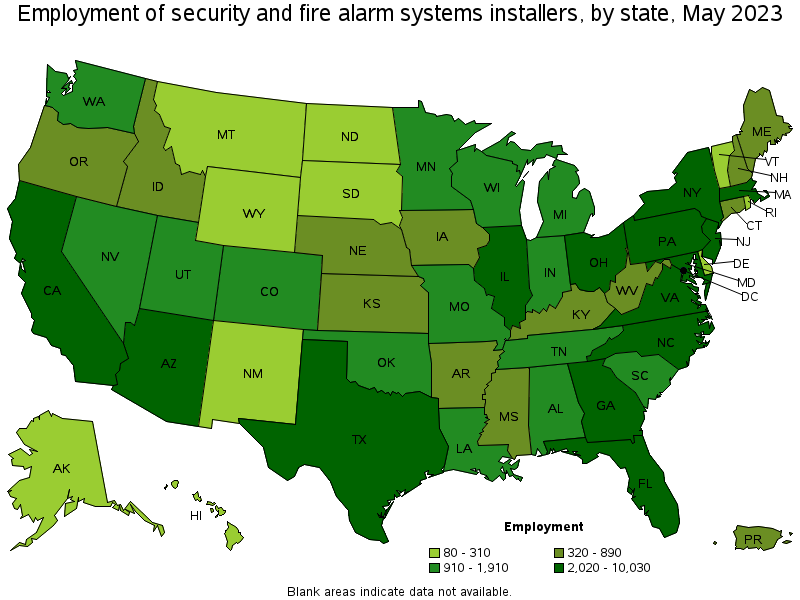
States with the highest employment level in Security and Fire Alarm Systems Installers:
| State | Employment (1) | Employment per thousand jobs | Location quotient (9) | Hourly mean wage | Annual mean wage (2) |
|---|---|---|---|---|---|
| Texas | 10,030 | 0.74 | 1.34 | $ 25.33 | $ 52,680 |
| Florida | 8,710 | 0.91 | 1.65 | $ 25.51 | $ 53,070 |
| California | 8,660 | 0.48 | 0.88 | $ 32.78 | $ 68,190 |
| New York | 4,150 | 0.44 | 0.80 | $ 30.72 | $ 63,890 |
| North Carolina | 3,170 | 0.66 | 1.20 | $ 24.06 | $ 50,050 |
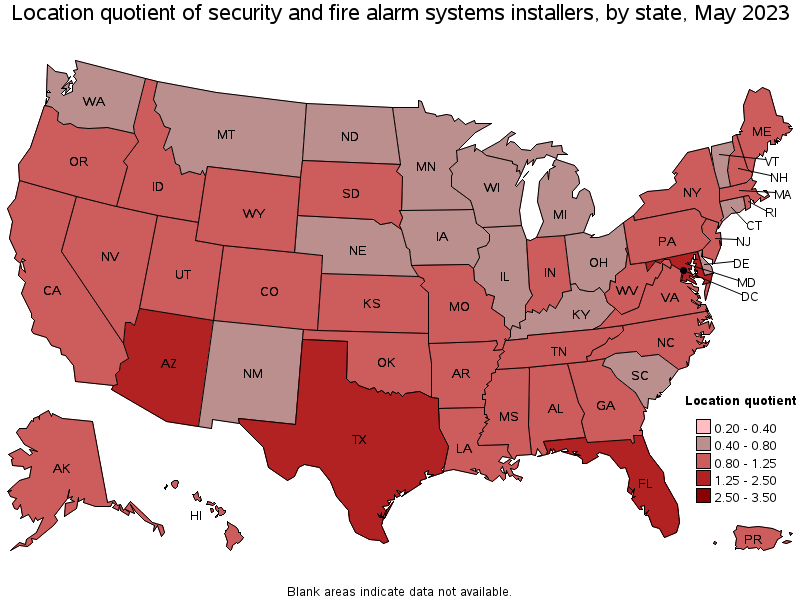
States with the highest concentration of jobs and location quotients in Security and Fire Alarm Systems Installers:
| State | Employment (1) | Employment per thousand jobs | Location quotient (9) | Hourly mean wage | Annual mean wage (2) |
|---|---|---|---|---|---|
| Maryland | 2,610 | 0.98 | 1.77 | $ 32.92 | $ 68,460 |
| Florida | 8,710 | 0.91 | 1.65 | $ 25.51 | $ 53,070 |
| Arizona | 2,830 | 0.90 | 1.64 | $ 27.13 | $ 56,430 |
| Texas | 10,030 | 0.74 | 1.34 | $ 25.33 | $ 52,680 |
| Colorado | 1,910 | 0.67 | 1.23 | $ 31.26 | $ 65,010 |
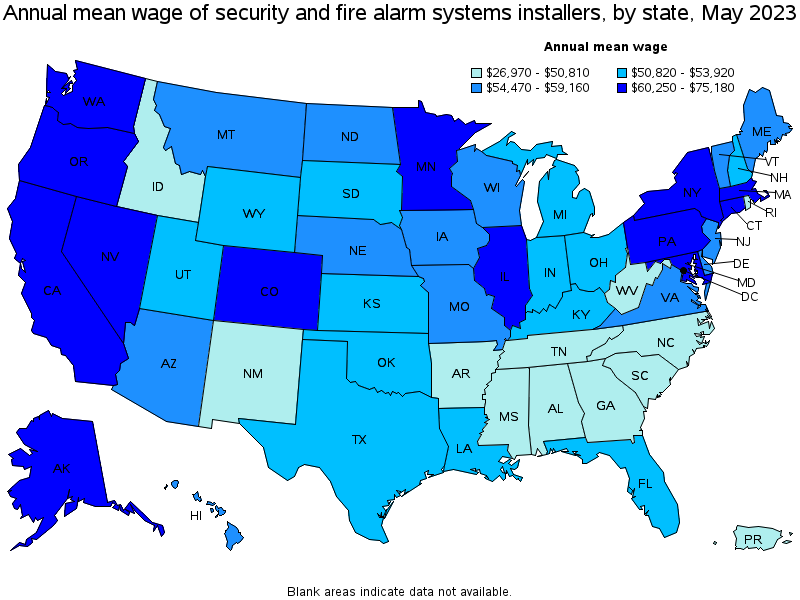
Top paying states for Security and Fire Alarm Systems Installers:
| State | Employment (1) | Employment per thousand jobs | Location quotient (9) | Hourly mean wage | Annual mean wage (2) |
|---|---|---|---|---|---|
| Minnesota | 1,010 | 0.35 | 0.64 | $ 36.15 | $ 75,180 |
| Washington | 1,250 | 0.36 | 0.65 | $ 33.72 | $ 70,130 |
| Oregon | 890 | 0.46 | 0.83 | $ 33.71 | $ 70,110 |
| Alaska | 160 | 0.53 | 0.96 | $ 33.38 | $ 69,430 |
| Maryland | 2,610 | 0.98 | 1.77 | $ 32.92 | $ 68,460 |
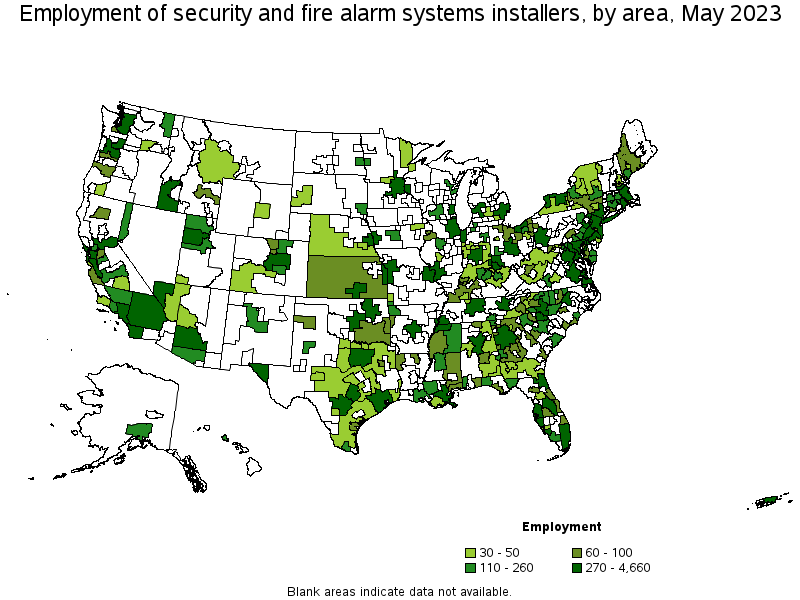
Metropolitan areas with the highest employment level in Security and Fire Alarm Systems Installers:
| Metropolitan area | Employment (1) | Employment per thousand jobs | Location quotient (9) | Hourly mean wage | Annual mean wage (2) |
|---|---|---|---|---|---|
| New York-Newark-Jersey City, NY-NJ-PA | 4,660 | 0.49 | 0.89 | $ 30.89 | $ 64,260 |
| Dallas-Fort Worth-Arlington, TX | 3,830 | 0.97 | 1.76 | $ 25.65 | $ 53,350 |
| Los Angeles-Long Beach-Anaheim, CA | 3,040 | 0.49 | 0.89 | $ 31.34 | $ 65,190 |
| Miami-Fort Lauderdale-West Palm Beach, FL | 2,710 | 1.00 | 1.81 | $ 25.32 | $ 52,660 |
| Phoenix-Mesa-Scottsdale, AZ | 2,450 | 1.07 | 1.95 | $ 27.60 | $ 57,400 |
| Houston-The Woodlands-Sugar Land, TX | 2,140 | 0.67 | 1.23 | $ 25.37 | $ 52,770 |
| Washington-Arlington-Alexandria, DC-VA-MD-WV | 2,050 | 0.66 | 1.21 | $ 31.78 | $ 66,100 |
| Boston-Cambridge-Nashua, MA-NH | 1,840 | 0.67 | 1.21 | $ 32.32 | $ 67,230 |
| Chicago-Naperville-Elgin, IL-IN-WI | 1,760 | 0.39 | 0.71 | $ 31.54 | $ 65,600 |
| Atlanta-Sandy Springs-Roswell, GA | 1,630 | 0.58 | 1.05 | $ 23.04 | $ 47,930 |
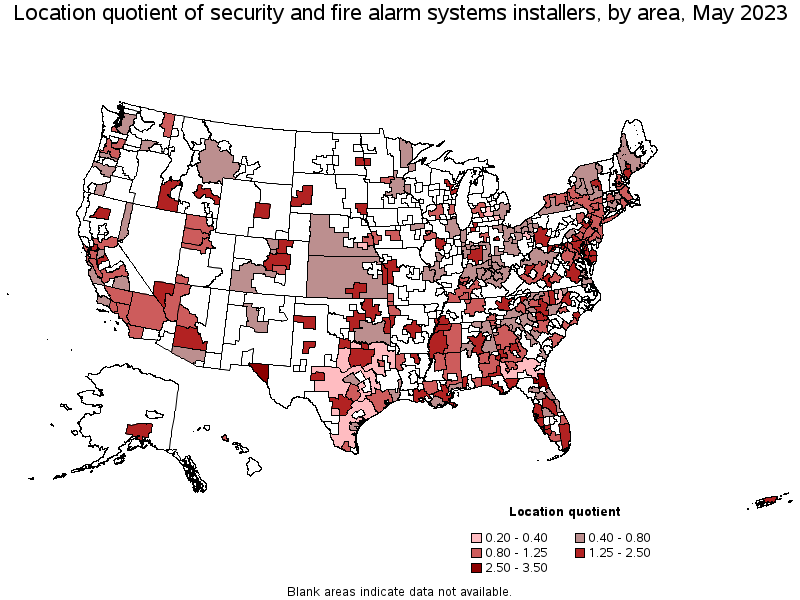
Metropolitan areas with the highest concentration of jobs and location quotients in Security and Fire Alarm Systems Installers:
| Metropolitan area | Employment (1) | Employment per thousand jobs | Location quotient (9) | Hourly mean wage | Annual mean wage (2) |
|---|---|---|---|---|---|
| Jacksonville, FL | 1,160 | 1.57 | 2.86 | $ 25.31 | $ 52,650 |
| El Paso, TX | 500 | 1.53 | 2.78 | $ 28.60 | $ 59,480 |
| Columbus, GA-AL | 160 | 1.37 | 2.49 | $ 20.94 | $ 43,560 |
| Casper, WY | 50 | 1.32 | 2.40 | $ 26.01 | $ 54,110 |
| Roanoke, VA | 200 | 1.31 | 2.39 | $ 23.48 | $ 48,830 |
| Cape Coral-Fort Myers, FL | 340 | 1.18 | 2.14 | $ 25.66 | $ 53,360 |
| Sioux Falls, SD | 180 | 1.08 | 1.97 | $ 25.93 | $ 53,930 |
| Phoenix-Mesa-Scottsdale, AZ | 2,450 | 1.07 | 1.95 | $ 27.60 | $ 57,400 |
| Hagerstown-Martinsburg, MD-WV | 110 | 1.05 | 1.92 | $ 25.74 | $ 53,540 |
| Crestview-Fort Walton Beach-Destin, FL | 130 | 1.03 | 1.88 | $ 24.93 | $ 51,850 |
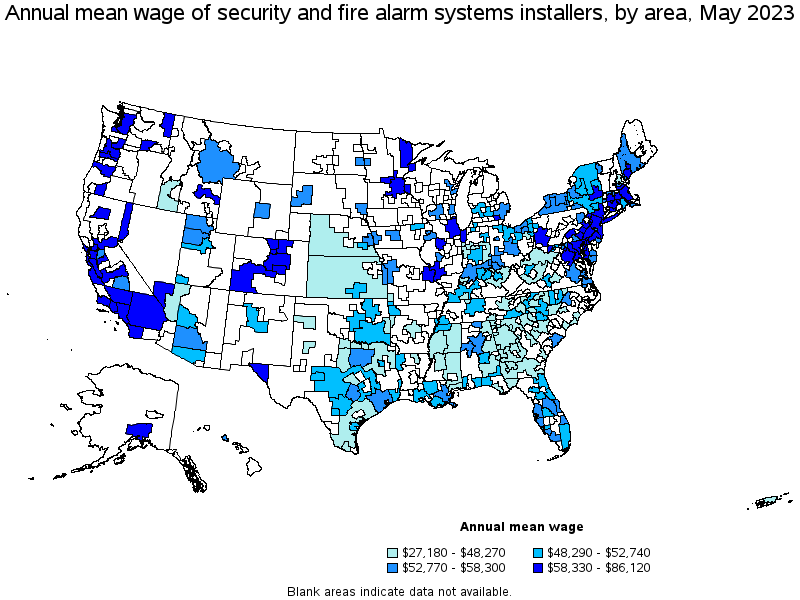
Top paying metropolitan areas for Security and Fire Alarm Systems Installers:
| Metropolitan area | Employment (1) | Employment per thousand jobs | Location quotient (9) | Hourly mean wage | Annual mean wage (2) |
|---|---|---|---|---|---|
| San Jose-Sunnyvale-Santa Clara, CA | 530 | 0.46 | 0.84 | $ 41.40 | $ 86,120 |
| San Francisco-Oakland-Hayward, CA | 1,170 | 0.48 | 0.88 | $ 38.03 | $ 79,100 |
| Minneapolis-St. Paul-Bloomington, MN-WI | 670 | 0.35 | 0.64 | $ 37.07 | $ 77,100 |
| Eugene, OR | 70 | 0.43 | 0.77 | $ 36.52 | $ 75,960 |
| Salem, OR | 60 | 0.32 | 0.58 | $ 34.85 | $ 72,490 |
| Seattle-Tacoma-Bellevue, WA | 730 | 0.35 | 0.64 | $ 34.62 | $ 72,000 |
| Anchorage, AK | 130 | 0.75 | 1.37 | $ 33.97 | $ 70,660 |
| Portland-Vancouver-Hillsboro, OR-WA | 690 | 0.58 | 1.05 | $ 33.87 | $ 70,460 |
| Baltimore-Columbia-Towson, MD | 1,270 | 0.97 | 1.77 | $ 33.24 | $ 69,150 |
| Ann Arbor, MI | 30 | 0.15 | 0.27 | $ 33.05 | $ 68,740 |
Nonmetropolitan areas with the highest employment in Security and Fire Alarm Systems Installers:
| Nonmetropolitan area | Employment (1) | Employment per thousand jobs | Location quotient (9) | Hourly mean wage | Annual mean wage (2) |
|---|---|---|---|---|---|
| Northeast Mississippi nonmetropolitan area | 140 | 0.61 | 1.11 | $ 18.93 | $ 39,380 |
| Piedmont North Carolina nonmetropolitan area | 110 | 0.42 | 0.76 | $ 22.55 | $ 46,900 |
| North Northeastern Ohio nonmetropolitan area (noncontiguous) | 100 | 0.30 | 0.55 | $ 23.65 | $ 49,180 |
| Southeast Mississippi nonmetropolitan area | 90 | 0.63 | 1.15 | $ 18.97 | $ 39,450 |
| Central East New York nonmetropolitan area | 90 | 0.55 | 1.00 | $ 24.72 | $ 51,430 |
Nonmetropolitan areas with the highest concentration of jobs and location quotients in Security and Fire Alarm Systems Installers:
| Nonmetropolitan area | Employment (1) | Employment per thousand jobs | Location quotient (9) | Hourly mean wage | Annual mean wage (2) |
|---|---|---|---|---|---|
| Maryland nonmetropolitan area | 60 | 0.94 | 1.71 | $ 31.21 | $ 64,910 |
| Northwest Mississippi nonmetropolitan area | 60 | 0.72 | 1.31 | $ 17.22 | $ 35,820 |
| Southeast Mississippi nonmetropolitan area | 90 | 0.63 | 1.15 | $ 18.97 | $ 39,450 |
| Northeast Mississippi nonmetropolitan area | 140 | 0.61 | 1.11 | $ 18.93 | $ 39,380 |
| Central New Hampshire nonmetropolitan area | 50 | 0.57 | 1.03 | $ 22.84 | $ 47,500 |
Top paying nonmetropolitan areas for Security and Fire Alarm Systems Installers:
| Nonmetropolitan area | Employment (1) | Employment per thousand jobs | Location quotient (9) | Hourly mean wage | Annual mean wage (2) |
|---|---|---|---|---|---|
| Maryland nonmetropolitan area | 60 | 0.94 | 1.71 | $ 31.21 | $ 64,910 |
| Southwest Colorado nonmetropolitan area | 40 | 0.39 | 0.70 | $ 30.16 | $ 62,720 |
| Southwest Montana nonmetropolitan area | 40 | 0.24 | 0.43 | $ 27.62 | $ 57,450 |
| Massachusetts nonmetropolitan area | (8) | (8) | (8) | $ 26.58 | $ 55,280 |
| Southwest New York nonmetropolitan area | 50 | 0.31 | 0.56 | $ 25.92 | $ 53,910 |
These estimates are calculated with data collected from employers in all industry sectors, all metropolitan and nonmetropolitan areas, and all states and the District of Columbia. The top employment and wage figures are provided above. The complete list is available in the downloadable XLS files.
The percentile wage estimate is the value of a wage below which a certain percent of workers fall. The median wage is the 50th percentile wage estimate—50 percent of workers earn less than the median and 50 percent of workers earn more than the median. More about percentile wages.
(1) Estimates for detailed occupations do not sum to the totals because the totals include occupations not shown separately. Estimates do not include self-employed workers.
(2) Annual wages have been calculated by multiplying the hourly mean wage by a "year-round, full-time" hours figure of 2,080 hours; for those occupations where there is not an hourly wage published, the annual wage has been directly calculated from the reported survey data.
(3) The relative standard error (RSE) is a measure of the reliability of a survey statistic. The smaller the relative standard error, the more precise the estimate.
(7) The value is less than .005 percent of industry employment.
(8) Estimate not released.
(9) The location quotient is the ratio of the area concentration of occupational employment to the national average concentration. A location quotient greater than one indicates the occupation has a higher share of employment than average, and a location quotient less than one indicates the occupation is less prevalent in the area than average.
Other OEWS estimates and related information:
May 2023 National Occupational Employment and Wage Estimates
May 2023 State Occupational Employment and Wage Estimates
May 2023 Metropolitan and Nonmetropolitan Area Occupational Employment and Wage Estimates
May 2023 National Industry-Specific Occupational Employment and Wage Estimates
Last Modified Date: April 3, 2024